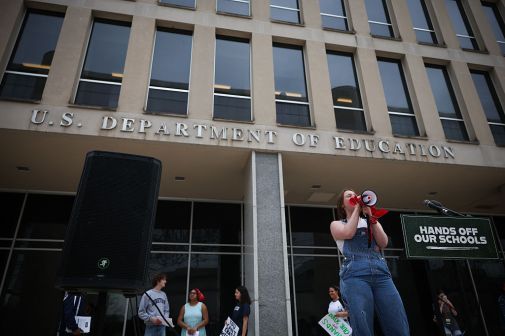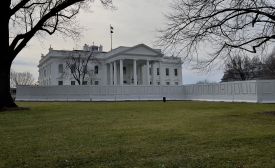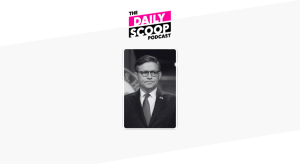 Andrew McMahon
Andrew McMahonPhoto: Ken Wright/AFFIRM
Andrew McMahon, senior advisor at the Office of Management and Budget and PortfolioStat lead, sat down with FedScoop Radio to give an update on the PortfolioStat program, trends he’s seen during the reviews and what lies ahead.
FedScoop: PortfolioStat has been a reality for about six months now or so, could you give an update just kind of where the program is?
McMahon: Yes, absolutely. So, the program – the execution phase of PortfolioStat – happened over the summer. We had agencies do quite a bit of work around beta call, developing draft and final plans, and then OMB did a lot of analysis. We came together for individual meetings with each of the 26 agencies throughout the month of July and a little bit into August.
At the end of August, the agencies submitted a final plan so we’re really at the end of phase one. The last couple months we’ve gone through the plans, and a lot of the initiatives that agencies are kind of undertaking over the next three years. We have one more deliverable in February that asks agencies to look at lessons learned, but for this year’s process we’re really at the tail end.
FedScoop: What have you taken away since you’ve attended all of these meetings? What are the kinds of things that you’ve taken away from them so far?
McMahon: One, there is a huge opportunity for agencies to really generate a lot of capital for innovative technologies for modernizations across some of their more legacy systems. They have an awesome opportunity to improve governments, to improve the CIO authorities across an agency, to improve evaluation models. We think that these are really going to be the fuel that drives the engine going forward, and we hope agencies will really execute on their plans, which have been fantastic coming in.
FedScoop: Are there certain things that you keep seeing time and time again in each agency?
McMahon: There isn’t one thing that we saw time and again. Agencies really did do a fantastic job looking at their investment review boards. So, if that was the one constant, I think investment review boards would be that one thing.
In the consolidation areas, in terms of where agencies are looking, infrastructure looks to be a big area that agencies are looking, and contract consolidations are something that agencies are looking at and I think that has to deal with you know contracts don’t. To consolidate a contract, you would be taking a huge amount of investment capital up front, where as a system it may take a year and some capital to actually consolidate systems across an organization.
So. I think agencies in these first couple of years are looking to generate that capital, they need to do some larger things – the business systems, the FM, the HR down the road.
FedScoop: Can you talk a little bit about the process of some of these meetings?
McMahon: Sure, I think the way my boss Steve VanRoekel, who is the federal CIO, likes to talk about them is that they were very much what an investment review board should look like. So, the senior leader of the agency that was in the room was the deputy secretary of the chief operating officer. Whichever the agency has, some smaller agencies don’t have deputy secretaries. Yes, the C-suite was in the room.
On our end, the budget and engine side of OMB was in the room. In fact, that didn’t just include our office but the acquisition office, the office of Federal Procurement Policy, and the senior leaders from those offices within OMB. So it really was a gathering of the folks who make decisions both within the agencies and also within OMB to really look at the direction that the agency was headed.
We were really there to provide an advisory role to essentially point out some things we were seeing in the data that they provided and the way they cut the data. To ask some questions around whether or not they really took bold steps and that the direction that they were heading was going to be beneficial to the federal government and to their organization.
The meetings themselves were led by the agencies. The agencies did a fabulous job. They took them very seriously, obviously. Within some of the senior leadership that was in the room they were very important to the meeting and it went very well. They were extremely happy walking away and so were we. We even got some great information at each of the meetings and we were able to share that information back to the agencies as we went to the subsequent meetings after that.
FedScoop: So the agencies had a pretty good response to these and really did a good job with them?
McMahon: I think that we’ve been seeing a really good response to the process overall. I think that plays a lot into the fact that it wasn’t a one size fits all. It was to tailor and provide data, let us show you what we are seeing and then really take some steps to what you as the leaders of the organization think are the best ways for you to improve. What are the gaps of weaknesses and how can you fill those gaps of weaknesses.
I think that really helps from a standpoint of a responsibility of ownership. They felt that they own the process, and we were there to provide insights, help analyze the data they provided and really provide any cover that they may need down the line if things were going to become challenging from the execution standpoint.
FedScoop: You said agencies have one more deliverable coming up. Are we going to do this all again next year? What does it look for in the future?
McMahon: Absolutely. In the memo itself it spells out pretty clearly that this will be an annual occurring process. What OMB will do in following through will probably release an update of the memo to say what will happen in the next year. We will likely see an earlier time table starting a little bit earlier in this spring than we did this year.
We expect to have this to be a recurring process and have agencies really be able to look back at how they executed because, as we do this in 2013, we will see how they did in years previous or in two years down the line. They will really get to look back into how they executed on their plans but also push the plan out year to year in each subsequent year and say “okay we’ve executed on this, what is the next big thing that we need to do?”
I think, as we get more mature in the process we will be able to tailor more to certain agencies. Agencies are at different places and they’ll mature in the process and it will allow us to say “okay, agency X really needs to focus on their CIO authorities, and agency Y really needs to focus on these three consolidation areas, how can we help them do that?” I think that as we get mature in the process we will become more tailored to what agencies needs.






